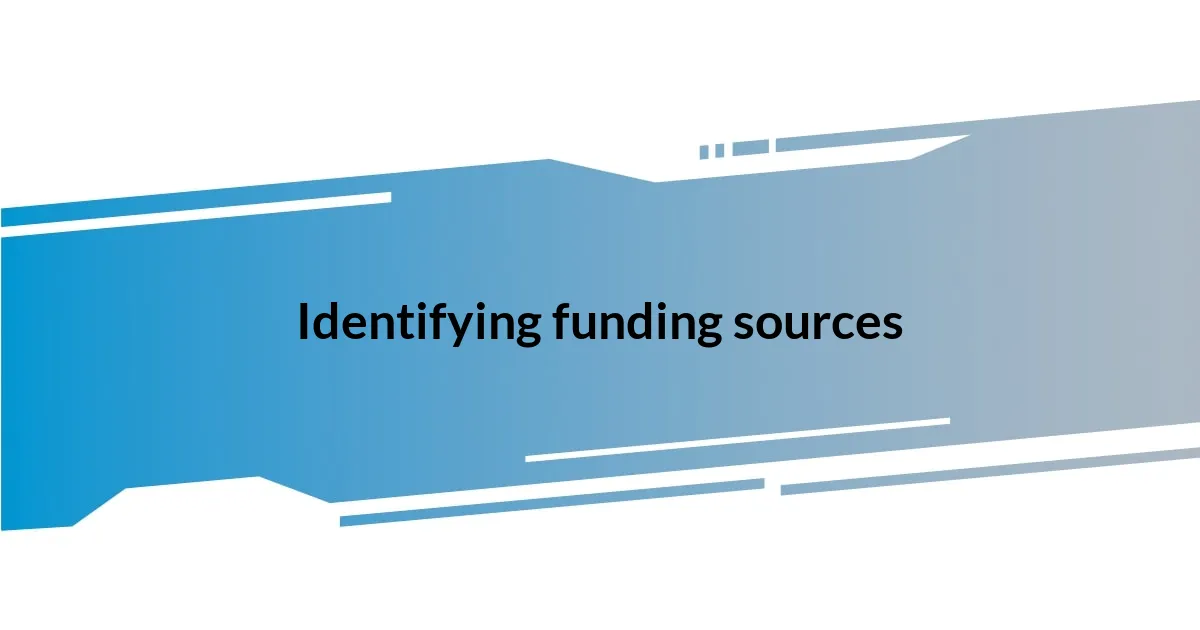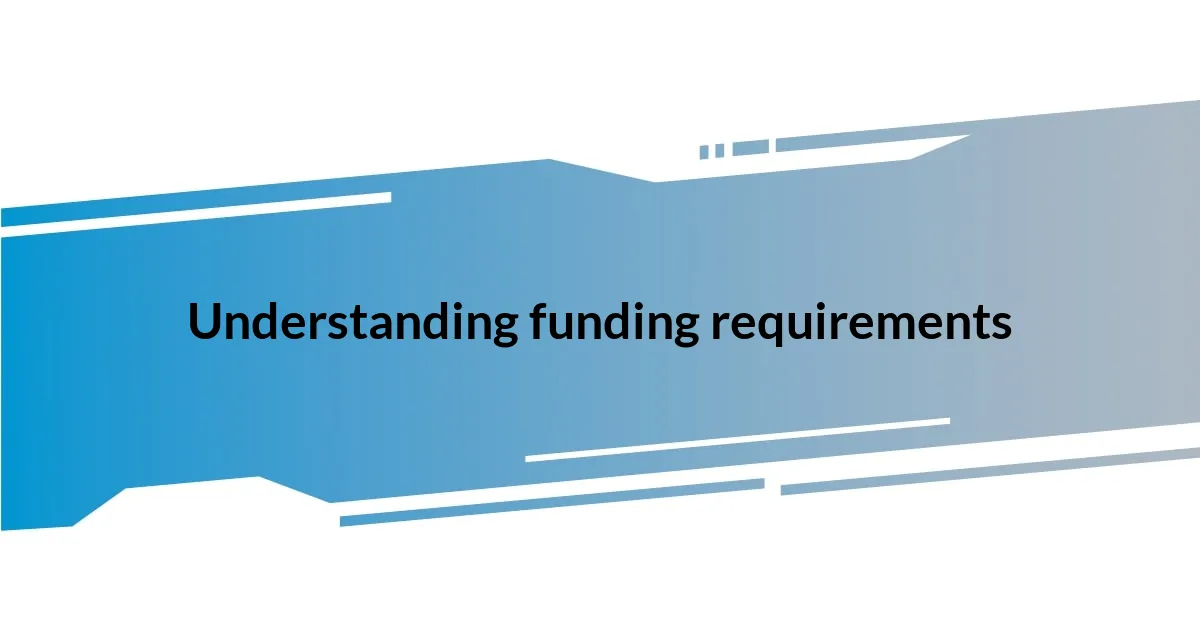Key takeaways:
- Align your project’s mission with funder values and thoroughly understand their requirements to enhance application success.
- Networking and building genuine relationships are crucial for uncovering funding opportunities and creating lasting connections.
- Utilize storytelling in proposals and crowdfunding, focusing on authentic experiences to engage potential backers and make your project relatable.

Identifying funding sources
Identifying suitable funding sources can often feel like searching for a needle in a haystack. I remember a time when I was determined to fund my first project; I scoured countless websites and databases. It was overwhelming, but each potential source felt like a glimmer of hope—there’s something invigorating about finding that perfect match.
When looking for funding, consider the specific needs of your project. Are you focused on social impact, innovation, or education? I’ve found that aligning your project’s mission with the values of funding organizations can significantly increase your chances of success. How often do we overlook this crucial alignment in our pursuit?
Networking also plays a pivotal role in identifying funding opportunities. One quiet evening, while attending a local event, I struck up a conversation with a fellow entrepreneur, which led me to an unexpected grant opportunity. Just think about it—how many chance encounters can turn into a transformative funding lead? Being open to conversations can open doors you never knew existed.

Understanding funding requirements
Understanding funding requirements can sometimes seem daunting, but I believe it shouldn’t be. From my experience, it’s essential to break down what each funder expects. For instance, I once applied for a grant that required detailed financial projections, something I had underestimated. Taking the time to fully understand their requirements made all the difference, transforming my application from a hidden gem to a compelling case for support.
Here are some key aspects to consider when researching funding requirements:
- Eligibility Criteria: Does your project fit the funder’s mission?
- Application Format: Are there specific templates or guidelines to follow?
- Funding Amount: What range is being offered, and is it sufficient for your needs?
- Reporting Obligations: What will you need to track or report on if you receive funding?
- Timeline: What are the deadlines for application submission and funding decisions?
I can’t stress enough how knowing these details upfront can save you time and heartache later. It’s almost like preparing for a big presentation; knowing your audience and their expectations can ease your nerves and set you up for success.

Exploring grant opportunities
When exploring grant opportunities, I often remind myself that each funding source holds its unique story and potential. In my early journey, I discovered the importance of not just applying for grants that seemed aligned on the surface, but also delving deep into their specific objectives. One time, while researching a particular grant, I realized it prioritized grassroots initiatives that genuinely resonated with my project’s community focus. That small revelation made all the difference in crafting a nuanced application that spoke directly to the heart of the funder’s mission.
I’ve also found that staying on top of grant announcements is crucial. I signed up for newsletters from various foundations, and what a game changer that was! The excitement of receiving updates filled with new grants feels much like opening a treasure chest filled with opportunities. It’s vital to keep an organized schedule or set reminders for application deadlines. After missing a couple of deadlines early on, I now ensure that I am proactive, which allows me to approach each new opportunity with enthusiasm and confidence.
Moreover, attending webinars and information sessions hosted by grantors can transform your understanding of the grant application process. I recall joining a session once where a program officer openly shared tips on how to craft a compelling narrative. It was enlightening, and I came away with a treasure trove of insights that I applied directly to my next application. Engaging with the grant community not only broadens your knowledge but also connects you with others who share similar goals, creating invaluable support networks.
| Grant Source | Focus Area |
|---|---|
| Local Arts Foundation | Community Arts Projects |
| Innovation Fund | Technological Advancement |
| Environmental Initiative Grant | Sustainability and Conservation |

Networking with potential investors
Reaching out to potential investors can be both exhilarating and intimidating. I remember attending a networking event where I struck up a conversation with a seasoned investor over coffee. As we talked, I realized that he valued authentic connections over polished pitches. That moment taught me the importance of being genuine; investors appreciate when you’re yourself rather than someone trying to fit a mold.
Building relationships is just as crucial as making an initial contact. For instance, I follow up with people I meet via LinkedIn or email, sharing interesting articles or updates related to our discussions. It’s a simple step that shows I value the connection, and in my experience, these small gestures can transform a fleeting meeting into a lasting relationship. Have I ever missed the chance to connect after a first meeting? Absolutely, and I learned the hard way that the follow-up can make or break potential funding opportunities.
Moreover, investing time in local entrepreneur groups has opened unexpected doors for me. At one gathering, I was introduced to a mentor who not only offered guidance but also connected me with funding sources I hadn’t considered. I often find myself wondering how many opportunities I’ve overlooked by staying in my comfort zone. Networking isn’t just about seeking funds; it’s about fostering a community of support where ideas flourish and collaborations can blossom effortlessly.

Creating a compelling proposal
Creating a compelling proposal is all about storytelling. I vividly remember my first attempt; I tried to dazzle the funder with jargon and overly complex ideas. Instead, what snagged their attention was a genuine story from my community—one that vividly illustrated the impact of the project. The lesson was clear: the essence of your proposal should be the heart of your mission, wrapped in a narrative that resonates emotionally.
Over the years, I’ve learned that clarity is king. Whenever I draft a proposal, I strive for simplicity and focus. Each section must answer a critical question: “How does this make a difference?” I recall a time when a mentor advised me to cut the fluff and direct my energy toward concrete outcomes. By aligning my goals clearly with the funder’s, I was able to transform a dense proposal into a clear, persuasive narrative that made them see exactly why supporting my project was a worthy investment.
But let’s be real—creating a compelling proposal can be daunting. I often ask myself, “What sets my project apart?” Reflecting on this has led me to highlight unique aspects, like unexpected community partnerships or innovative approaches that challenge traditional methods. Approaching a proposal with fresh eyes can unveil hidden strengths, turning what might feel like just another application into a standout submission that captures attention right away.

Leveraging online crowdfunding platforms
Leveraging online crowdfunding platforms has become a game-changer for many entrepreneurs, including myself. I remember when I first explored these platforms; the idea of sharing my vision with the world was both exciting and a little daunting. Could strangers truly resonate with my passion? To my surprise, they did. Sharing my journey online and receiving support from people I had never met turned a solitary venture into a vibrant community backing my dream.
One of the most rewarding aspects of crowdfunding, in my experience, is the storytelling element. I discovered that presenting my project authentically struck a chord with potential backers. Instead of focusing solely on numbers and projections, I shared my personal experiences and challenges. This approach not only humanized my project but also created a sense of connection. Do you wonder how you might engage your audience the same way? I found that vulnerability often invites support, making backers feel invested not just in a project but in a shared vision.
Additionally, I learned the importance of offering rewards that resonate with my supporters. I once brainstormed rewards for backers of a creative project I launched and realized that experiences often matter more than tangible items. By providing personalized updates or even small meet-and-greet opportunities, I fostered loyalty among my supporters. Have you considered how your rewards can deepen the relationship with your backers? This tactic transformed my campaign from a mere funding source to a collaborative experience, inviting my community to be part of something bigger which ultimately led to incredible success.

Evaluating alternative financing options
Evaluating alternative financing options requires a thoughtful examination of what each choice can truly offer. I remember when I first faced the prospect of exploring different funding avenues beyond traditional loans. I was surprised to discover the range of options—like peer-to-peer lending or angel investors—each with its own unique dynamics. It made me ponder: what aligns best with my values and project vision?
When considering alternative options, there’s no denying the importance of doing your homework. I recall a time when I didn’t fully grasp the implications of equity financing. It was a moment of enlightenment when I understood that bringing in investors could mean giving up some control over my business. This realization shifted my perspective entirely. Have you taken the time to weigh the pros and cons of each potential source? Reflecting on this can be a critical step toward making an informed decision.
Moreover, tapping into community resources can often be overlooked. I stumbled upon local organizations that offer grants and support for projects focused on social impact. I learned that these opportunities not only provide funding but also foster relationships within the community. Have you thought about how localized funding could amplify your project’s reach? By embracing these approaches, I found that alternative financing options could turn out to be more than just money; they can also provide valuable connections and a sense of belonging.
